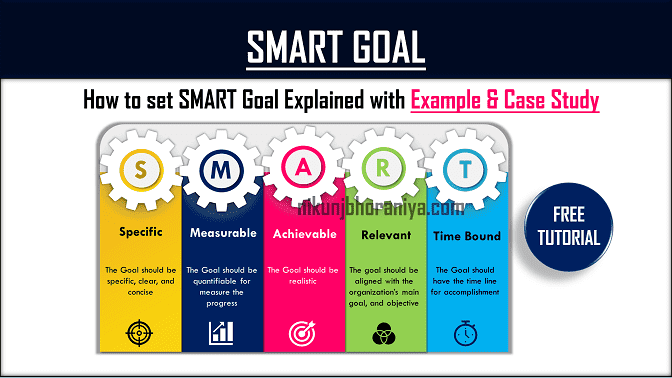What is the SMART Goal in the Six Sigma Project?
→ A SMART goal is an acronym that stands for Specific, Measurable, Achievable, Realistic, and Time-bound.
→ Therefore, SMART goals integrate all of these criteria to help us increase the possibilities of achieving your goal.
→ The project’s goals and objectives can be defined based on the project scope and problem statement.
→ Goal Statement defines the expected improvement that we want to do.
→ Goal Setting is part of the Define phase in the DMAIC Methodology of Six Sigma.
→ It should be mentioned in clear, concise, and measurable terms in the goal statement.
→ In the Six Sigma Project charter, after defining the problem statement the next step is to define the goals.
How to Set SMART Goal Explained with Case Study
→ As we know that the SMART goal is an acronym that stands for the below five words.
- S - Specific
- M - Measurable
- A - Achievable
- R - Realistic
- T - Time-Bound
→ We will understand this method in detail.
→ Goal Setting is the very basic stage for all Six Sigma Projects.
01. S - Specific:
→ The goal statement should not be generic or philosophic. It should be specific, clear, concise, and well defined so everyone can understand them very easily.
→ We can also use the word significant instead of specific.
→ During goal setting, we need to be specific about what we want to achieve.
➨ To make sure that we are setting up a specific goal with the help of the below four questions:
→ Who — Who is required in a project for achieving the goal?
→ What — What exactly we want to achieve? we need to write it down in detail.
→ Which — Determine which resources, skills are required to achieve our goal.
→ Why — What is the reason for setting and achieving the goal?
02. M - Measurable:
→ The goal should be measurable so it will help team members for making progress.
→ Measurable means the parameters that we will consider to measure if we have achieved a goal or not?
→ We can also know as goal KPIs.
→ It makes a goal more beneficial because it gives us a way to measure our progress.
→ Sometimes measuring progress is difficult without the proper defining goals.
→ Measurements should be quantitative or qualitative in nature.
03. A - Achievable:
→ The goal statement should be achievable and realistic.
→ Also, we can understand achievable by attainable, or acceptable.
→ All teammates should be agreed on the taken goal.
→ While we are setting the goals, we also need to consider if we have sufficient resources, finance, and skills to achieve the goal or not?
→ Also, take the approval from the team during the setting the goal.
→ Communicate to top management if you require any support like tools, talent, software, budget, etc.
04. R - Relevant:
→ The goal must be in line with the strategic goals of the organization.
→ The goal should be relevant to our business or organization's vision & mission.
→ It should be in line with the short-term and long-term business objectives.
→ That helps to work in the right direction.
→ Sometimes instead of word relevant other words like reasonable, and realistic are used.
→ The goal should be realistic that means it should be achieved within the available knowledge and resources.
05. T - Time-Bound:
→ The goal statement must have a timeline for starting and completion.
→ We can also say time-based, or time-bound goals.
→ We need to set our goals timeline in a realistic time frame.
→ Sufficient and optimum time to be given for completing the goal.
→ Too much high or low time period should not be given for completing the goal. It will create a negative impact on performance.
→ Also, we need to take approval from the project team on the timeline.
→ Defining the timeline for any project that will help you to achieve the goal within the timeline and also we can track the progress of it.
Examples of SMART Goal in Lean Six Sigma Project
→ Goal Statement: "To Improve the OEE of Line A from the current baseline of 45% to 65% in the next six months. It will give the tangible benefits of 10K USD."
- S - Specific - OEE Improvement of Line A
- M - Measurable - Measurable in %
- A - Achievable - Agreed by Team - Improvement from 45% to 65%
- R - Realistic - It will save the 10K USD that is relevant to our business objectives
- T - Time-Bound - Next six month
Goal Setting Example 02:
→ Goal Statement: "Reduce the Rejection of product A from 2.32% to 1% in the next three months will give the tangible benefits of 5K USD."
- S - Specific - Reduction in Rejection of Product A - Quality Improvement
- M - Measurable - Measurable in %
- A - Achievable - Agreed by Team - The reduction in Rejection from 2.32% to 1%.
- R - Realistic - It will save the 5K USD that is relevant to our business objectives
- T - Time-Bound - Next three months
Tips for setting Effective SMART Goals:
→ Brainstorm with team members on all the aspects of goal setting.
→ The entire team needs to take ownership of the goals to make it successful.
→ The brainstorming will help fine-tune your strategy, ensuring the goals are achievable.
→ Everyone should be on the same page to make it effective.





إرسال تعليق